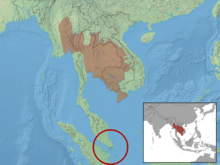Finlayson's squirrel
| Finlayson's squirrel | |
|---|---|
.jpg) | |
| Scientific classification | |
| Kingdom: | Animalia |
| Phylum: | Chordata |
| Class: | Mammalia |
| Order: | Rodentia |
| Family: | Sciuridae |
| Subfamily: | Callosciurinae |
| Genus: | Callosciurus |
| Species: | C. finlaysonii |
| Binomial name | |
| Callosciurus finlaysonii (Horsfield, 1823) | |
| Subspecies | |
|
15+ subspecies.[2]
| |
 | |
Finlayson's squirrel or the variable squirrel (Callosciurus finlaysonii, sometimes misspelled C. finlaysoni) is a species of rodent in the family Sciuridae. It is found in Cambodia, Laos, Myanmar, Thailand, and Vietnam. The subspecies C. f. floweri, which is adapted to urban parks and gardens around Bangkok has been introduced in the Serangoon area of Singapore. There are also two introduced populations in Italy, probably a result of the species' popularity in the pet trade; both are thought to be of subspecies C. f. bocourti;[3] it is possible that some of the Callosciurus squirrels introduced into Japan are also Finlayson's squirrels.[4]
The pelage colour in this species is extremely variable; currently 16 subspecies are recognised, including C. f. ferrugineus which has been treated as a separate species.[2] The subspecific name of C. f. boonsongi commemorates Thai zoologist and conservationist Dr. Boonsong Lekagul.
Like other squirrels of its genus (the "beautiful squirrels", Callosciurus), Finlayson's squirrel is normally a canopy-dweller, feeding mainly on fruit (Kitamura et al., (2002).[5] Field evidence suggests that it has the usual form of dichromatic mammalian colour vision, which may enable it to discriminate ripe from unripe fruits (Tamura et al., 2015).[6]
References
- ↑ Duckworth, J. W.; Timmins, R. & Parr, M. (2008). "Callosciurus finlaysonii". IUCN Red List of Threatened Species. Version 2008. International Union for Conservation of Nature. Retrieved 6 January 2009.
- 1 2 Thorington, R.W., Jr.; Hoffmann, R.S. (2005). "Callosciurus finlaysonii". In Wilson, D.E.; Reeder, D.M. Mammal Species of the World: a taxonomic and geographic reference (3rd ed.). The Johns Hopkins University Press. ISBN 0-8018-8221-4. OCLC 26158608.
- ↑ Bertolino, S., & Lurz, P. W. W. (2013). Callosciurus squirrels: worldwide introductions, ecological impacts and recommendations to prevent the establishment of new invasive populations. Mammal Review, 43, 22-33. doi:10.1111/j.1365-2907.2011.00204.x
- ↑ Kuramoto, T., Torii, H., Ikeda, H., Endo, H., Rerkamnuaychoke, W., & Oshida, T. (2012). Mitochondria DNA sequences of Finlayson's squirrel found in Hamamatsu, Shizuoka Prefecture, Japan. Mammal Study, 37, 63-67
- ↑ Kitamura, S., Yumoto, T., Poonswad, P., Chuailua, P., Plongmai, K., Maruhashi, T., & Noma, N. (2002). Interactions between fleshy fruits and frugivores in a tropical seasonal forest in Thailand. Oecologia, 133, 559-572.
- ↑ Tamura, N., Fujii, Y., Boonkeow, P., & Kanchanasaka, B. (2015). Colour vision and food selection of Callosciurus finlaysonii (Sciuridae) in tropical seasonal forests. Journal of Tropical Ecology, 31, 449-457.
External links
- Wildlife Singapore Photos and description
- Ecology Asia Photos and description
- Photo gallery showing some of the variations of Finlayson's Squirrel.
